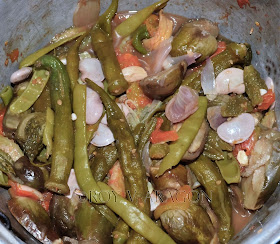This is the way we (well, me, actually, and if I say "we", my late mother would be a very special and a most honorable mention here because it was her who influenced me, and virtually taught me, all things about pinakbets, dinengdengs, and anything nateng) cook the great Ilokano signature dish pinakebbet, or more popularly known as pinakbet, (not the non-Ilokano [because grammatically incorrect] Tagalogized "pakbet") in Casantolan (Nueva Vizcaya), my place of birth and early domicile, and my place of longing to be settled at again, to get back in and to return to, well, soon.
And, this is the way I cook pinakbet whenever I am in Casantolan--what with the ready ingredients available and with the cooking wares and familiar cooking traditions I was used to as a barrio boy (again, all thanks, I owe it to my mother).
On one of my random visit, I came upon these available veggies ready at home, bought at the market in Bambang and some picked right in the backyard garden: paria, tarong, okra, bunga ti singkamas, kamatis.
I began preparing the veggies. I am happy that I chanced upon this rather rare opportunity to have these smallish native bitter melons and this variety of eggplant which is just so good for this Ilokano signature dish, the small okras, and yes, the jicama fruit.
On one of my random visit, I came upon these available veggies ready at home, bought at the market in Bambang and some picked right in the backyard garden: paria, tarong, okra, bunga ti singkamas, kamatis.
I began preparing the veggies. I am happy that I chanced upon this rather rare opportunity to have these smallish native bitter melons and this variety of eggplant which is just so good for this Ilokano signature dish, the small okras, and yes, the jicama fruit.
Of course, the tomatoes. And onion and ginger. The onions are chopped, the ginger is crushed for it to give its maximum zing.
For a while, I remember something that will make my pinakbet more gorgeous and delicious. I went by the shrubberies and climbing vines and gathered some patani (also called "pulomingko") pods. These are a very good companion to an Ilokano pinakbet, I promise!
This is how I cut the tarongs. And here they are in the cooking pot. Level by level. And drenched atop with bugguong "juice". I didn't put any water. The veggies' own juices, and the bugguong's, will suffice. It will "agdanum" later as the kamatis will give all its essence to "pakbet" its veggie friends.
And here, I cooked it just the way a good pinakbet should be cooked--using firewood on a DIY iron stove in a makeshift "dirty kitchen" outside the house.
::::
More, about pinakbet:
- Pinakbet a nadumaduma
- Pinakbet ingredients
- Various authentic, exotic, Ilokano pinakbets
- Pinakbet with kaggo
- More pinakbet from Ilokanos around the web
- Pinakbet a nakaparparia
For more Ilokano vegetable dishes, you can follow Ilokano Food page on Facebook and enjoy more sumptuous photos of dinengdeng and other vegetable dishes plus more veggies!
Follow also Ilokano Food @ Instagram and subscribe to Ilokano Food YoutTube channel for more photos, videos, and stories about Ilokano food, cooking, cuisine, and culture.























I’m so glad you still continue to update this blog. I can’t ever get enough of dinengdeng. My lola died at 106 years old anything this practically every day.
ReplyDeleteNagimasen!
ReplyDeleteJust how my mom and grandma taught me. Love that nateng!
ReplyDelete